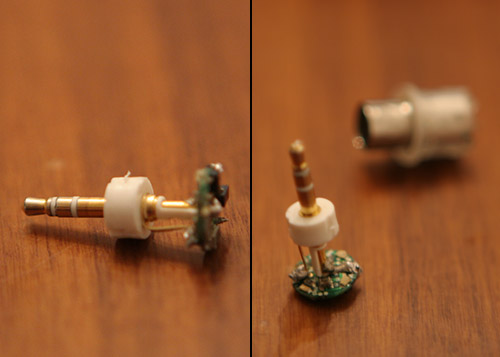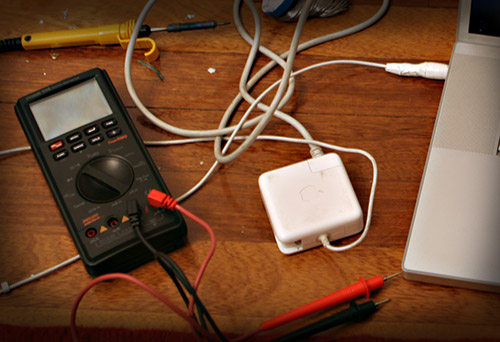In a few weeks my laptop will be 4.5 years old. And for all intents and purposes it still holds its own pretty well for practically everything, but the most CPU-intensive tasks. Tasks that I typically perform on much faster desktop machines anyway.
Some weeks ago the laptop, a 2003 17″ Apple Powerbook G4, started exhibiting pretty weird symptoms: the laptop would intermittently ‘lose’ the AC adaptor, or it would stop charging. This would happen at different times, without any movement of the device or the power brick. There were times I left the laptop on all night on battery power and connected to the AC adaptor, only to find the battery completely drained and the laptop in a weird power state — not completely off, not sleeping, but certainly not charging either.
I was initially very perplexed by this behaviour and was ready to write the laptop off — it is ageing and I have been meaning to replace it for a long time, although I never quite found a good reason for doing so until now.
Some weeks ago the frequency of the symptoms increased to the point where action had to be taken to remedy them. I was still using the laptop by that time and I was planning a trip away for the period around the (Orthodox) Easter — which meant that I would definitely be needing it during that time.
The laptop
After disassembling the laptop and checking the main logic and DC boards for any cracked solder joints (I didn’t find any), I cleaned the interior of the machine from any dust particles that had entered the laptop from the rear vents and reassembled it. As a sidenote: the Powerbook uses the Sunon MagLev fans which do not require oiling and are more or less expected to last for 50K hours of use before failing. Cleaning the dust around them made the machine somewhat quieter. Since I hadn’t found any obvious problems inside the computer, the issues I was experiencing seemed to be stemming from either the AC adaptor or the plug.
The AC adaptor and plug
The Apple Powerbook AC adaptor design is a remnant from the Titanium Powerbook era and also used for the iPod series of products. For my PowerBook this is a 65W charger providing 24.5V DC (i.e. up to 2.65A). The charger is pretty well engineered, welded shut and wrapped in the same tough polycarbonate plastic as the iBook or the newer MacBook.
Still one or more components in AC adaptors should be expected to die after some thousand hours of use, and my laptop saw really heavy use between 2004-2006. Before writing the adaptor off I had to check the plug.
 This is where the fun part starts. For that generation of computers (and the one before it) Apple chose to ‘create’ their own adaptor plug — like it did with the currently used ‘Magsafe’ plug. The 3D rendering of a model of the adaptor I quickly put together in blender, shows how the plug looks. In my case the plug consists of a 2.5 mm TRS plug (1) — the smaller cousin of the 6.3mm and 3.5mm plugs typically used for audio connections in consumer electronics — surrounded by a cylindrical protective ‘shield’ made of metal (2) that also serves as a power conduit to the four LEDs located inside the plug on a small PCB (3). A plastic lightguide (not shown in the graphic) serves in creating the green or orange ‘glowing’ indicator.
This is where the fun part starts. For that generation of computers (and the one before it) Apple chose to ‘create’ their own adaptor plug — like it did with the currently used ‘Magsafe’ plug. The 3D rendering of a model of the adaptor I quickly put together in blender, shows how the plug looks. In my case the plug consists of a 2.5 mm TRS plug (1) — the smaller cousin of the 6.3mm and 3.5mm plugs typically used for audio connections in consumer electronics — surrounded by a cylindrical protective ‘shield’ made of metal (2) that also serves as a power conduit to the four LEDs located inside the plug on a small PCB (3). A plastic lightguide (not shown in the graphic) serves in creating the green or orange ‘glowing’ indicator.
While many people have reported problems with the cable sheath breaking and causing shorts or the solder joints of the cables breaking, my problem was — strangely — unrelated to the normal strains associated with the plug: the solder joint connecting the ‘live’ cable to the sleeve was inexplicably broken. Note that this joint doesn’t typically ‘see’ much strain.

In the process I also noticed that the green kevlar/nylon threads following the copper wires had also leaked at the strain relief point so I decided to cut the cable shorter. In any case, I had broken the white plastic cover and in the process destroyed the PCB (my soldering iron has a much larger tip than needed for this job).

The Powerbook now works on AC reliably again and it charges the battery as expected. The casualties of this small ‘surgery’ are the LED indicators (that could’ve been avoided if I had a smaller tip on the iron) and the original (and really cool) plastic strain relief. The added bonus is the punk look of the plug, although I’m sure I’m going to have to be somewhat more careful with it from now on.
